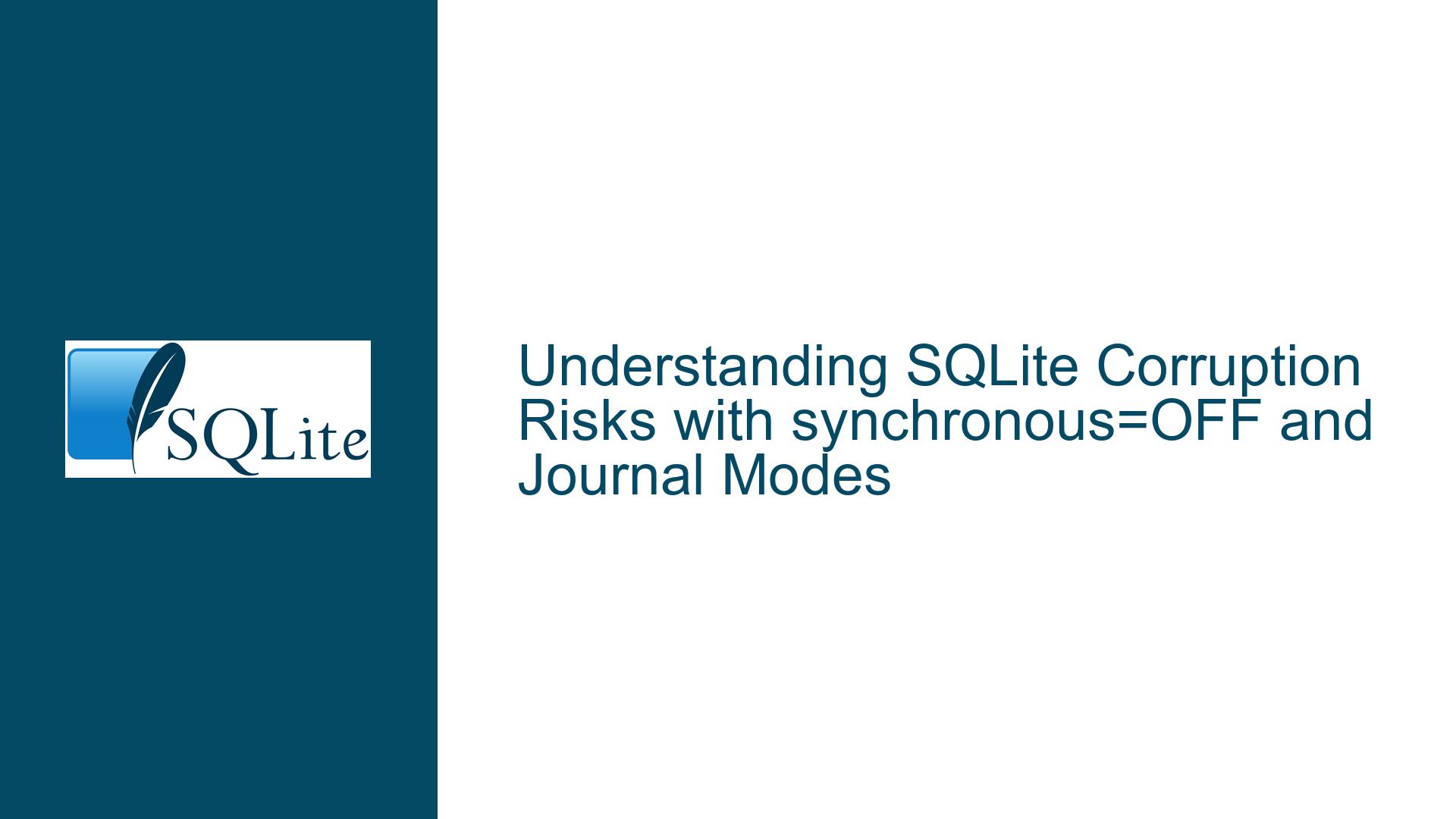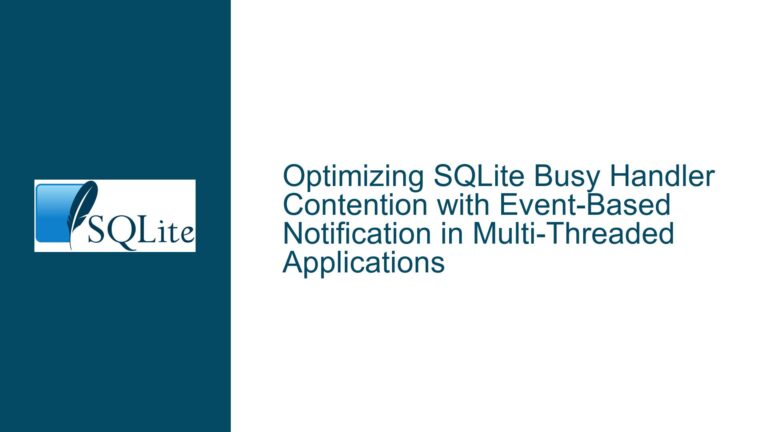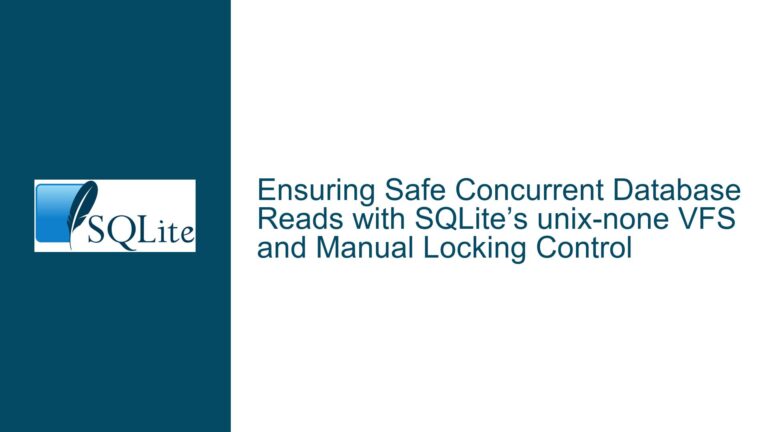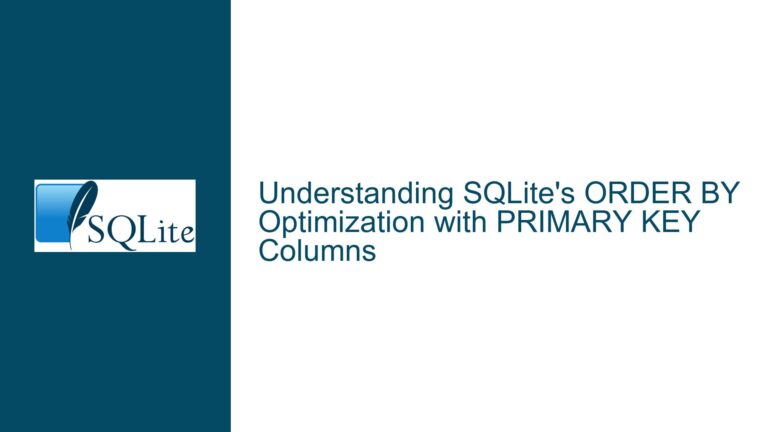SQLite Corruption Risks with synchronous=OFF and Journal Modes
How SQLite Handles Data Integrity with synchronous=OFF and Journal Modes
1. The Interaction Between synchronous=OFF, Journal Modes, and Corruption Risks
SQLite’s PRAGMA synchronous setting and journal modes (e.g., WAL or DELETE) are critical for balancing performance and data integrity. When synchronous=OFF is enabled, SQLite skips calls to fsync() or equivalent operating system functions that ensure data is physically written to storage. This omission significantly accelerates write operations but introduces risks of data loss or corruption during power failures, application crashes, or operating system crashes.
Journal modes like Write-Ahead Logging (WAL) and DELETE influence how SQLite manages transactions. In DELETE mode, changes are first written to a rollback journal file, then applied to the main database. After a successful transaction, the journal file is deleted. In WAL mode, changes are appended to a separate write-ahead log file, and the main database is updated asynchronously during checkpoints.
The core concern with synchronous=OFF is that SQLite cannot guarantee the order or atomicity of writes to the database and journal files. For example:
- In DELETE mode, if a crash occurs after the database file is modified but before the journal file is deleted, the database may be left in an inconsistent state.
- In WAL mode, incomplete writes to the WAL file or reordered writes between the WAL and main database can lead to mismatched transaction records.
The distinction between data loss and corruption is crucial:
- Data loss refers to losing recent transactions that were not fully persisted.
- Corruption occurs when the database file or journal/WAL files are left in an inconsistent state, rendering the database unreadable or partially readable.
The risk of corruption depends on factors such as:
- The journal mode in use.
- Whether the operating system and storage hardware honor write ordering.
- The timing of crashes relative to SQLite’s internal write operations.
2. Why synchronous=OFF Can Lead to Corruption Even with Journaling Enabled
The primary causes of corruption when using synchronous=OFF stem from the lack of enforced write ordering and durability guarantees. Below are the technical reasons why corruption can occur:
A. Write Reordering by the Operating System or Hardware
Without fsync(), the operating system’s I/O scheduler or storage hardware (e.g., SSDs with wear-leveling) may reorder write operations. For example:
- In DELETE mode, the journal file might be deleted before the corresponding database changes are fully written to disk. After a crash, the database would lack both the journal and the completed transaction, leading to inconsistency.
- In WAL mode, changes to the WAL file and the main database might be written out of order. If a crash occurs before a checkpoint completes, the WAL might reference database pages that were never updated.
B. Partial Writes to Journal or WAL Files
When synchronous=OFF is enabled, SQLite does not wait for the OS to confirm that journal/WAL writes are complete. A power failure mid-write could leave these files with incomplete or garbled data. While WAL files include checksums to detect invalid entries, a partially written WAL header or frame could bypass these checks, causing the database engine to misinterpret the log.
C. Checkpointing in WAL Mode
In WAL mode, checkpoints transfer changes from the WAL file to the main database. With synchronous=OFF, checkpoints may not flush these changes to disk reliably. If a crash occurs mid-checkpoint, the WAL file and database could disagree about which transactions are committed.
D. Filesystem and Hardware Misbehavior
Even “honest” filesystems and drives can fail to persist writes in the order they were issued. For example:
- A filesystem might batch writes to improve performance, delaying the physical write of critical journal metadata.
- A drive’s write cache might reorder operations before committing them to non-volatile storage.
3. Mitigating Corruption Risks and Safeguarding Data Integrity
A. Avoid synchronous=OFF for Critical Databases
The SQLite documentation explicitly warns against using synchronous=OFF for databases where corruption is unacceptable. Alternatives include:
synchronous=NORMAL(WAL mode): Provides a balance between performance and safety. Transactions are not synced to disk immediately, but checkpoints includefsync()calls.synchronous=FULL(DELETE mode): Ensures all writes are synced, minimizing corruption risks at the cost of slower write speeds.
B. Use WAL Mode with synchronous=NORMAL
WAL mode is more resilient to corruption than DELETE mode when used with synchronous=NORMAL. Key advantages:
- Transactions are appended to the WAL file without modifying the main database until a checkpoint.
- Checksums in the WAL file help detect incomplete or corrupted transactions, which SQLite will ignore during recovery.
- Checkpoints sync the main database, ensuring periodic durability.
C. Implement Application-Level Safeguards
- Regular Backups: Use SQLite’s
.dumpcommand or file-level backups to create restore points. - Checksum Validation: Periodically verify database integrity using
PRAGMA integrity_check. - Controlled Checkpoints: Manually trigger checkpoints during low-activity periods to reduce WAL file growth and sync changes to the main database.
D. Test for Hardware and Filesystem Reliability
- Disable Write Caching: Ensure the drive’s write cache is disabled or backed by uninterruptible power.
- Use a Journaling Filesystem: Modern filesystems like ext4 or NTFS provide better metadata consistency than older alternatives.
E. Monitor and Handle Corruption Gracefully
- Error Detection: Catch
SQLITE_CORRUPTerrors and switch to a backup database if corruption is detected. - Logging: Log checkpoint times, transaction counts, and backup schedules to diagnose corruption causes.
By adhering to these practices, developers can achieve high performance without compromising data integrity. The risks of synchronous=OFF far outweigh its benefits for most applications, and safer configurations are almost always preferable.






